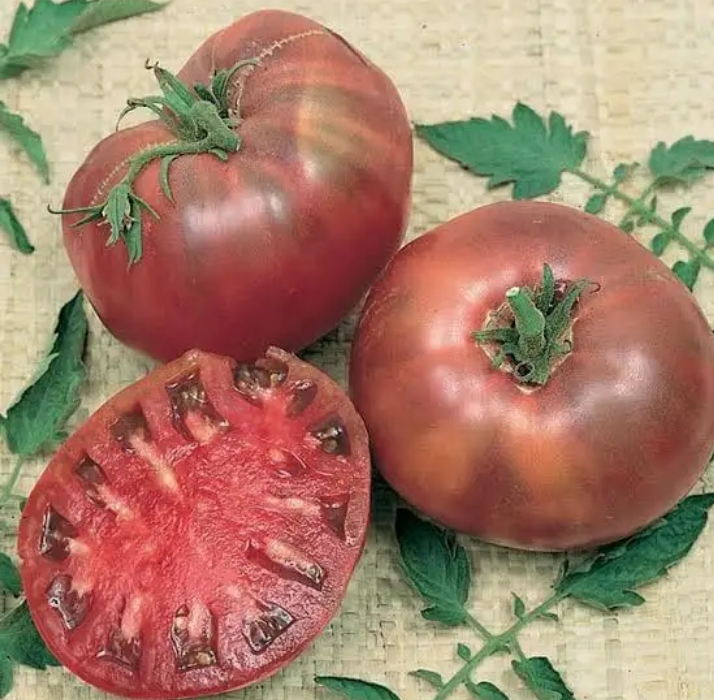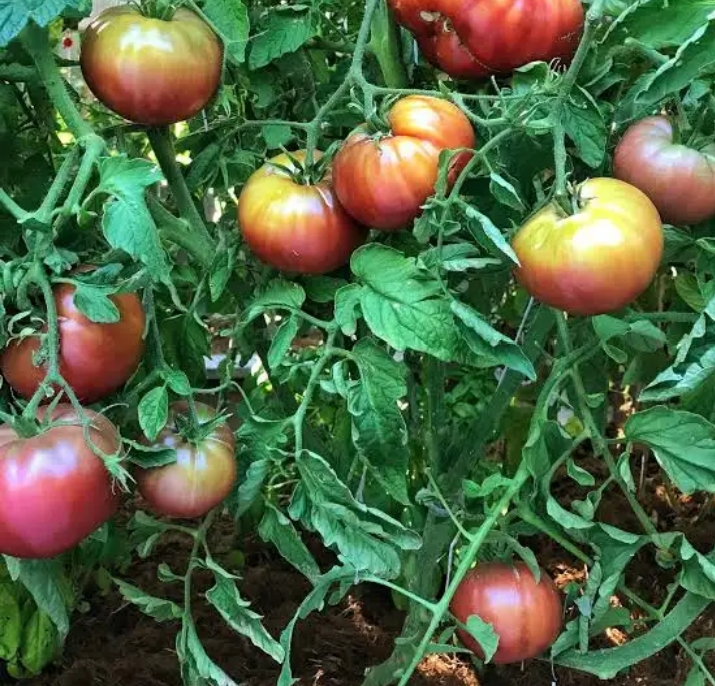What Is Cherokee Purple Tomato?
Cherokee Purple is an indeterminate heirloom variety of tomato grown for their excellent flavor and notes. This variety develops a fruit with a deep, dusky-rose color and deep rich flavor while maintaining a somewhat greenish hue near the stem when mature for eating. The deep crimson interior and clear skin combination give it its distinctive color. The Cherokee Purple tomato belong to the “beefsteak” group of tomatoes, meaning that it is very juicy and large with a robust flavor and is best enjoyed fresh without cooking.
The Cherokee Purple tomato entered the gourmand’s lexicon in the 1990’s after a Tennessean, John Green, mailed seeds of t delicious fruit to Craig LeHoullier of the Seed Saver’s Exchange. Green wrote that he had received the seeds from a woman who had in turn been given the seeds by neighbors. These neighbors had grown the tomatoes for a century and originally procured them from Cherokee growers.

Characteristics Of Purple Cherokee Tomato
Cherokee Purple tomatoes get their name from their skin, which boasts rich, dusty shades of purple and pink with shoulders that are often green. Its flesh is a deep rose with wet and red, sometimes green, with small seed locules irregularly scattered throughout the flesh. The Cherokee Purple tomato’s flavor consists of a rich combination of mostly sweet, and some acidic notes.
The Cherokee Purple tomato is most commonly available in the summer and fall. This tomato is best enjoyed fresh and is often used sandwiches and salads. It can also be used when making pizza and pasta sauces. Cherokee purple tomatoes are often available as transplants in garden centers and nurseries across United States.
Cherokee Purple Plant
Cherokee Purple tomato are heirloom plants, which means you can save the seeds and store them for sowing the following season. It is a slow-growing tomato with few leaves and plenty of flowers. This is a highly productive open pollinated tomato variety, producing fruit that can weigh at least 340 grams (12 oz), though take a long time to ripen. The fruit mature in about 85-90 days from the time transplanting. More importantly, it is a versatile tomato with ability to adapt to any home organic vegetable garden.
Like most tomatoes, Cherokee Purple tomatoes grow in nearly any climate that provides plenty of sunlight and three to four months of warm, dry weather. Soil should be rich and well drained. The plant generally grows between 5-8 feet and has a fairly good resistance to gardening diseases and pests. Given that its an indeterminate type, this vigorous plant will obviously require staking or caging as yields can excess 20 pounds per plant.

How To Grow And Care For Cherokee Purple Tomato
Cherokee tomato plants are pretty resilient and can grow in most climates. But there are still some things you should think about before you start planting them. You will need to start the tomatoes indoors in seed-starting trays or planters, six to eight weeks before the last frost date in your area.
Planting Site/Location
Cherokee tomato plants grow best when grown in a location that receives direct sun throughout the day. They also require to be grown in a fertile fairly loose or well-drained soil and in this case sandy loam or loam soils are idea. If the soil is compacted or has a lot of clay you can improve the drainage by tilling the soil and amending it with sand, sawdust, peat moss, organic matter or other amendments. It is also important to know that Cherokee variety doesn’t do well in dry soils, neither anywhere standing water gathers after a rain.
Planting
You can start planting Cherokee tomato in your garden when the soil is warm enough for them to sprout. Tomato seedlings started indoors adjust to transplanting or outdoor conditions faster when they are exposed to outdoor conditions for roughly a week before they are transplanted. During transplanting, space the plants at least 24 inches apart and space rows 2 to 3 feet apart, leaving enough room for caging, staking and harvesting plants.
Mulching
Spread 3 or 4 inches of organic mulch over the soil around the base of your plants, pulling it back at least 3 inches from the stems. Tomatoes become stressed when their roots are too hot or dry and mulching is just but one way of providing the necessary protection. Mulch has a net effect of reducing moisture loss from the soil through evaporation and preventing weed from growing around the tomato plant.
Staking
Staking is an important cultural practice that can lead to a healthier and more abundant harvest. Staking Cherokee is not a complex process, simply drive a wooden or metal stake into the ground near your plant and gently ties the stem to the stake using twine or yarn and continue doing the same as the stems grow. Heavy plants with numerous fruits should have taller stronger metal stakes whereas plants with less fruit can just do with wood or bamboo.
Water Needs
Cherokee tomatoes typically plants have different watering needs depending on whether they are grown in planters or garden. Tomatoes grown in planters require more water than garden tomatoes. The planters or containers lose water easily from evaporation. They need to be watered at least twice a day (morning and evening). A good rule of the thumb for container growing tomatoes is to water until water runs freely from the bottom.
Garden growing tomatoes require about 1 to 2 inches of water each week to fruit. That means, watering them once in a day will be enough, but during dry seasons it is good to water them twice in day to maintain consistently moist soil.
Fertilizer
Cherokee just like other tomatoes require fertilizing. Both water-soluble and granular fertilizers are ideal. Though what you need to know is that, using a fertilizer that is high in nitrogen will only give you lush, green foliage with few fruits. Cherokee require a low nitrogen, high phosphorous and medium to high potassium content. A fertilizer with nitrogen, phosphorous, potassium ratio of 8-32-16 if often the best.
Growing Challenge
Cherokee tomatoes are prone to many problems including insect pests, cultural problems and disease. Here is a list of some of them:
Insects pests may include:
- Tiny leaf-sucking insects such as Psyllids
- Aphids
- Cutworms
- Flea beetles
- Hornworm
Cultural problems may include:
- Yellowing or wilting
- Stunted growth
- Fruit cracking
- Blossom drop
- Plant falling over
- Tomato leaf roll
- Sunscald
Diseases may include:
- Mosaic virus
- Blossom end rot
- Early blight
- Fusarium wilt
- Powdery mildew
Seeds
Cherokee Purple Seeds are generally available on Amazon or in many plant seed stores around United States at an affordable cost depend on your quantity preference. Alternatively, Cherokee Purple being a Heirloom variety, you can buy the tomatoes from the grocery and save the seeds for yourself.
Saving Cherokee Purple tomato seeds is not a complex affair. Every tomato seed is covered in a gelatinous sack which contains chemicals that inhibit seed germination. This prevents the seeds from sprouting whilst inside the tomato fruit. In nature the fruit drops from the plant and slowly rots away on the ground. This is the natural fermentation process and it is during this that the gelatinous sacks are destroyed. To save tomato seeds yourself you need to duplicate the fermentation process. This will not only remove the gelatinous sack but also kills any seed borne tomato diseases.
Begin with cutting the tomato fruits across the middle and then squeeze the seeds and the accompanying content into a container. Store the content in a cool dry place for at least five days, stirring them once or twice daily. When the mold has covered the top of the container add water and stir the mixture. Pour off the excess water and strain the seeds out of the remaining liquid. The seeds that collect at the bottom of the glass are more likely viable.
Take the seeds, wash them clean and then spread them out on a glass or ceramic plate to dry, a process which can take between 7 and 12 days. Stir the seeds once or twice daily so that they don’t stick together and to ensure all sides dry evenly. Save the seeds in an envelope or a dry tin till planting time. Saved seeds should store for 5 – 10 years if kept in the right conditions.
Key Takeaways
- Cherokee purple seeds are believed to have been passed down from Native Americans of the Cherokee tribe who lived in Tennessee before 20th century.
- The tomato is dusky pink in color with a deep, rich-red interior.
- Cherokee Purple tomatoes are beefsteak variety which is notable for having a dense, juicy texture, with small seed locules irregularly scattered throughout the flesh.
- Cherokee Purple tomato is best enjoyed fresh without cooking.